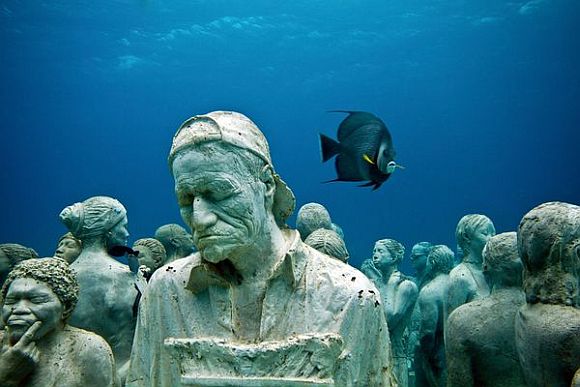MUSA – Explore Art Under The Sea In Mexico!

Living in Mexico, I have discovered many fascinating attractions that I might never have come across had I not decided to reside here. For example, did you know there is an entire underwater museum of 500 life-size sculptures off the coast of Playa del Carmen? The notion is intriguing, but when I saw pictures and videos of these sensational works, I became determined to view them for myself! MUSA, the Underwater Museum of Art located near the island of Isla Mujeres, is currently comprised of two galleries. The first exhibit, The Manchones displays 477 submerged statues and the other, Punta Nizuc has 23 masterpieces.

The idea for the underwater exhibition was brought to life by Dr. Jaime González Cano and sculptural artist, dive instructor, underwater naturalist and photographer, Jason deCaires Taylor. Two of the main focal points for its creation were to present an other world art appreciation experience, while providing what would become a platform for marine organisms such as coral, sponges, seaweed and algae to be able to grow and flourish.
Artificial reefs are usually formed by sunken shipwrecks. However, these unique sculptures made from high-density, PH-neutral marine cement, fiber glass rods and silicone are engineered to endure water submersion for many years and provide a stable base for coral formation to commence. The images were also designed with holes in order to provide shelter for and to foster local marine life.

Established in 2009, the statues were brought out to the dive site, which stretched over an approximately 420 square meter area of barren seabed. A 40-ton crane was placed on a commercial ferry and a special lift was designed to carefully lower the art pieces to the seafloor without damaging them.
Every visit to the subaquatic museum is an extraordinary encounter as over the years, the artwork acquires more live growth and is subject to the variant shifting of the environment below the surface of the sea. Naturalists believe that over time, only the outline of the figures will be visible, as the sculptures will be overcome with marine organisms.
A third important factor behind the concept to develop the museum was to draw tourism attention away from the local decaying reefs. Each year over 750,000 tourists arrive in Cancun to dive and explore the spectacular Mesoamerican Reef system. Unfortunately, due to unawareness and carelessness, the reef is being destroyed by divers, snorkelers and anchors. Now, because several companies offer excursions to tour the site of the remarkable MUSA museum, the local reefs have the opportunity to recover.
Submerged in depths of 3 to 6 meters, the collection, named “Silent Evolution”, depicts both the negative and positive interactions between humans and nature. The artist, Jason deCaires Taylar’s intention was to portray through his vision, the possibility of a functional future in which people and nature coincide harmoniously. From the negative aspect, his work displays the indifferent attitude of humans towards the destruction of the reefs caused by their own hand.

One piece called “The Dream Collector,” features dozens of glass bottles which enclose inspiring secret messages left from those hoping for change and progress regarding environmental awareness. One note from Roberto Diaz, President of MUSA reads: “May our hearts never become as hard as our heads.”
Another composition portrays businessmen with their heads buried in the sand. Each piece tells a story of either an objective for humans and nature to integrate and coexist in unison or, from the other perspective, of people turning a blind eye to the issues of our environment such as the decimation of the coral reefs.

The response generated in the last five years has been overwhelmingly positive. The underwater museum continues to successfully perpetuate marine conservation and encourage environmental consciousness. The phenomenal MUSA project has generated public mindfulness and a deeper understanding of the delicate ecosystems of the undersea world.

Since these wonderfully diverse ecological communities provide food and shelter for 33% of all marine fish species, we must all do our part to help sustain the coral reefs of the world. Reefs act as forests under the sea. Without enough coral in the ocean waters, the levels of carbon dioxide will rise and that will affect every living being on Earth.
Rising ocean temperatures as a result of global warming cause major damage and even death to entire coral colonies. By using energy efficient appliances and recycling, we can do our part to lower the effects of global warming. Another manner by which we can help preserve reef systems is to avoid touching coral when scuba diving and snorkeling, as well as to refrain from anchoring over a coral reef.
